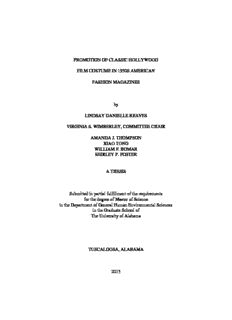
PROMOTION OF CLASSIC HOLLYWOOD FILM PDF
Preview PROMOTION OF CLASSIC HOLLYWOOD FILM
PROMOTION OF CLASSIC HOLLYWOOD FILM COSTUME IN 1930S AMERICAN FASHION MAGAZINES by LINDSAY DANIELLE REAVES VIRGINIA S. WIMBERLEY, COMMITTEE CHAIR AMANDA J. THOMPSON XIAO TONG WILLIAM F. BOMAR SHIRLEY P. FOSTER A THESIS Submitted in partial fulfillment of the requirements for the degree of Master of Science in the Department of General Human Environmental Sciences in the Graduate School of The University of Alabama TUSCALOOSA, ALABAMA 2013 Copyright Lindsay Danielle Reaves 2013 ALL RIGHTS RESERVED ABSTRACT The world of twenty-first-century fashion evolves into new forms at a more rapid pace when compared with clothing developments of the past. Elements of previous fashion trends are constantly recycled into new clothing to appease the public’s cravings. But, to whom does the public look for fashion inspiration? According to the “trickle-down” theory proposed by Simmel (1904) and Sproles (1985), the lower classes turn to the upper classes to find out what styles are in vogue at the moment. Although emulation of upper-class fashions appears to have been happening for some time, it seems fashion inspiration was “kicked into high gear” with the glamorous effects and global outreach of American Hollywood cinema, beginning in the 1930s. When the American film industry boomed in the first half of the twentieth century, actors became the inspiration for fashion as well. The glamour exuding from the Hollywood films produced during the 1930s inspired and influenced the clothing choices of the American public. Well-known costume designers such as Gilbert Adrian, Edith Head, Travis Banton, Howard Greer, Walter Plunkett, and Orry-Kelly designed costumes and personal clothing for many Hollywood leading ladies. Greta Garbo, Marlene Dietrich, Joan Crawford, Norma Shearer, Bette Davis, Claudette Colbert, Carole Lombard, Katharine Hepburn, Jean Harlow, and Kay Francis were some of the Hollywood stars whose costumes and personal wardrobes inspired the fashion trends of the 1930s. This research, using content analysis of photo layouts and advertisements in 1930s issues of Vogue, Vanity Fair, and Harper’s Bazaar, documents examples of two costume designers— Travis Banton and Orry-Kelly—and four Hollywood stars (Bette Davis, Marlene Dietrich, Kay ii Francis, and Carole Lombard) who influenced American women’s dress during the 1930s decade. Thirty-seven advertisements and editorials featuring the costume designer, the actress, or the actress with her costume designer were analyzed for the timing of promotion, the type of promotion, and the garment or accessory pictured. The results of this research show that although Banton and Orry-Kelly were two-thirds of the great triumvirate of Hollywood costume designers, the promotion of their designs did not occur very frequently in the selected fashion magazines. iii DEDICATION This thesis is dedicated to my University of Alabama undergraduate film studies professor, Dr. Jeremy G. Butler, who inspired my love for classic Hollywood films, and to my thesis committee chair and major professor, Dr. Virginia S. Wimberley, who provided me with much appreciated emotional and academic support, as well as engaging conversations about old Hollywood during my master’s studies. iv LIST OF ABBREVIATIONS AND SYMBOLS a Cronbach’s index of internal consistency M Mean: the sum of a set of measurements divided by the number of measurements in the set p Probability associated with the occurrence under the null hypothesis of a value as extreme as or more extreme than the observed value r2 Coefficient of determination: the statistic for determining the goodness of fit for predicting the outcome of the dependent variable based upon the inclusion of the independent variable < Less than > Greater than = Equal to v ACKNOWLEDGMENTS I am pleased to have this opportunity to thank the colleagues, friends, and faculty members who have helped me with this research project. My deepest gratitude goes to Virginia S. Wimberley, the chairperson of this thesis, for sharing her research experience and vast knowledge regarding historic costumes. I would like to thank all of my committee members, William F. Bomar, Shirley P. Foster, Amanda J. Thompson, and Xiao Tong, for their vital input, thought-provoking questions, and support of this thesis. I would also like to thank Sarah Cover for her assistance in analyzing and interpreting data and Sarah Roberts for her help in reviewing the production information of the Hollywood films involved in this thesis and invaluable computer skills. This research would not have been remotely possible without the support of my friends, fellow graduate students, and my family who never stopped encouraging me that I had the ability to achieve success in whatever I do. Finally, I thank the library staffs of Amelia Gayle Gorgas Library at the University of Alabama, Ralph Brown Draughon Library at Auburn University, and Library West of the George A. Smathers Libraries at the University of Florida. vi CONTENTS ABSTRACT ................................................................................................ ii DEDICATION ........................................................................................... iv LIST OF ABBREVIATIONS AND SYMBOLS ........................................v ACKNOWLEDGMENTS ......................................................................... vi LIST OF TABLES ..................................................................................... ix LIST OF FIGURES .....................................................................................x 1. INTRODUCTION ...................................................................................1 a. Assumptions .............................................................................................6 b. Limitations ...............................................................................................6 c. Operational Definitions ............................................................................8 2. REVIEW OF LITERATURE ..................................................................9 a. The Designers.........................................................................................14 b. The Actresses .........................................................................................16 c. Previous Research ..................................................................................18 d. Hypotheses .............................................................................................19 3. METHODOLOGY ................................................................................21 4. RESULTS ..............................................................................................25 5. DISCUSSION ........................................................................................31 6. IMPLICATIONS AND FUTURE RESEARCH ...................................38 vii REFERENCES ..........................................................................................40 APPENDIX A ............................................................................................45 APPENDIX B ............................................................................................48 viii LIST OF TABLES 4.1 Count of occurrences of Hollywood costume designers’ designed film garments and accessories appearing in 1930s issues of Vogue, Vanity Fair, and Harper’s Bazaar .......................................................25 ix
Description: